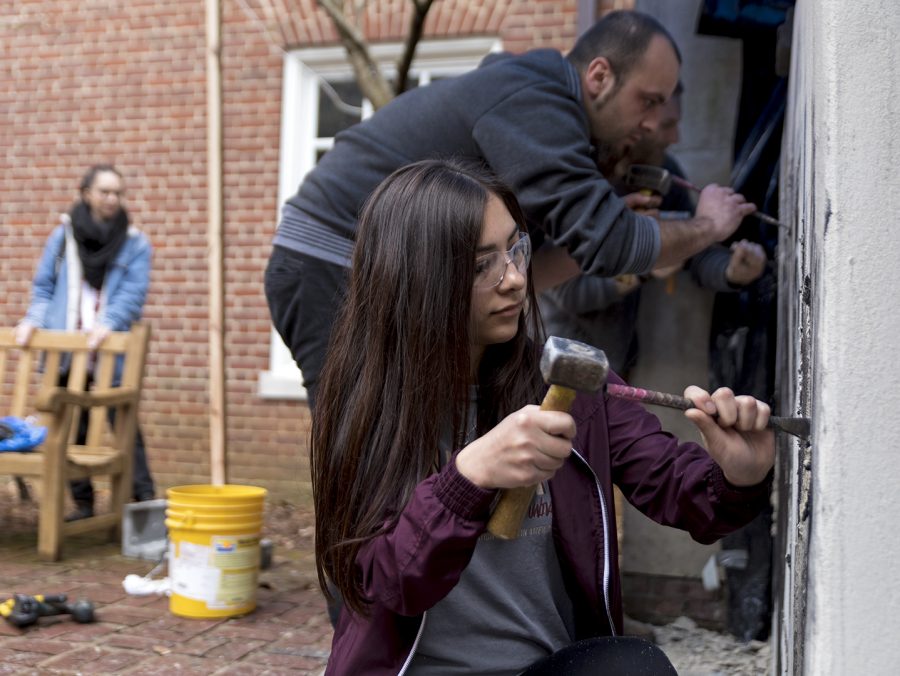Artist Talk features Bosnian artist collective
March 1, 2018
Grise Hall auditorium was lightly humming with the noise of the audience waiting for the events of the evening to begin on Feb. 28.
After a few minutes of adjustments to the sound system the coordinator of the talk, professor of art Yvonne Petkus, spoke.
The Feb. 28 HAD Collective Artist Talk introduced the themes and philosophies that went into the work on display at “Proof of Existence,” an exhibit of work by contemporary artists of Bosnia and Balkan origin. The exhibit has been held in the art gallery of the Ivan Wilson Fine Arts Center since Jan. 22 and will be held until April 6.
The exhibit features the works of the HAD Collective, a Bosnian artist collective who were the main subjects of the Artist Talk, and who spoke following Petkus. The artists are architect Muhamed Bešlagić-Hamo, fine artist Anel Lepić and street artist Damir Sarač.
Petkus, who is curator of the exhibition, detailed the development of the exhibition that started from the Zuheir Sofia Endowed International Faculty Seminar trip to Bosnia and Herzegovina in honor of the International Year of Bosnia and Herzegovina.
Faculty from many disciplines learned about and explored the country during the trip.
Petkus summarized her goals in regards to the exhibit and trip.
“I was doing research on my work, for my teaching, and to bring something back here,” she said. “From the beginning I was planning on doing an exhibition. So I was looking for artwork. I was also looking at the Bosnian diaspora. Because there so many Bosnians in the U.S., I was also looking at story too. I intentionally included artists of varied experiences with the [Bosnian] war. So I tried to have varied voices and varied ages so there is a diversity being represented.”
Following this introduction Ilhana Babic, 31, who has worked with the HAD Collective as their videographer and photographer since nearly the beginning of the Collective, started to speak. Babic has been instrumental in spreading the word about the Collective’s work.
“I wanted to spread the word not just locally…but outside of Bosnia.” Babic said. After she spoke, two other artists spoke.
The HAD Collective first started on June 15, 2015, when the three artists finished their piece “The Passenger.” The three artists got together and did work on the inside of an abandoned grain tank. They carved into it to create images using techniques from their diverse arts backgrounds.
When they finished their work there, they signed their initials creating the HAD Collective name.
Their work began illegally, with some in their town viewing it as vandalism, before gaining prestige in 2015 with series of work called “Walls,” which depicted images of common individuals that didn’t possess social capital and was done in the same grain tank.
With the gained prestige of their initial showing, they transitioned into their work from the isolation of the grain tank detailing work about random individuals to the streets and walls of Visoko proper with a piece called “Silence,” which depicted those who lost their lives during the Srebrenica massacre.
Srebrenica had casualties of over 8,000 Bosnian Muslims, or Bosniaks, who were dispatched by Bosnian Serbs during the Bosnian war in which the three ethnic groups Serbian, Croatian, and Bosniaks that comprise the population of Bosnia and Herzegovina engaged in conflict with one another. The Srebrenica massacre was a part of a larger genocide committed by the Bosnian-Serb forces against the Bosniaks.
All members of the Collective were children during the conflict and are of Bosniak ethnicity. “Silence” brought them into a larger spotlight, being covered in major publications internationally, including the Huffington Post.
The HAD Collective began working with WKU students on creating images in the courtyard of the Kentucky Museum on Tuesday, Feb. 27 and will finish Friday, March 2.
Reporter Spencer Wells can be reached at 270-745-6291 and [email protected].



















![Megan Inman of Tennessee cries after embracing Drag performer and transgender advocate Jasmine St. James at the 9th Annual WKU Housing and Residence Life Drag Show at Knicely Conference Center on April 4, 2024. “[The community] was so warm and welcoming when I came out, if it wasn’t for the queens I wouldn’t be here,” Inman said.](https://wkuherald.com/wp-content/uploads/2024/04/smith_von_drag_3-600x419.jpg)


